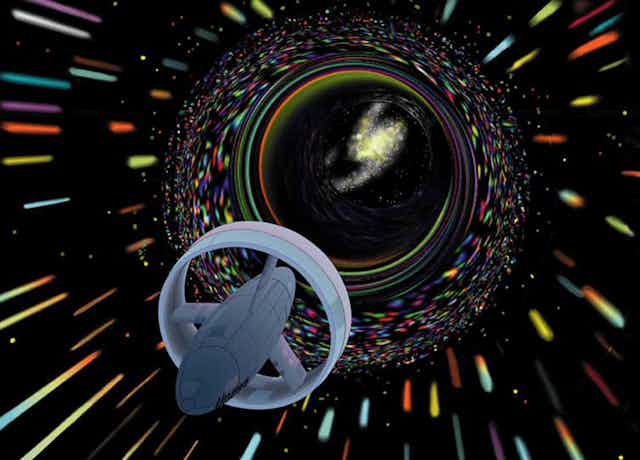

Warp drives: Physicists give chances of faster-than -light space travel a boost
Associate Professor of Physics, Oklahoma State University
Disclosure statement
Mario Borunda does not work for, consult, own shares in or receive funding from any company or organisation that would benefit from this article, and has disclosed no relevant affiliations beyond their academic appointment.
Oklahoma State University provides funding as a member of The Conversation US.
View all partners
The closest star to Earth is Proxima Centauri. It is about 4.25 light-years away, or about 25 trillion miles (40 trillion km). The fastest ever spacecraft, the now- in-space Parker Solar Probe will reach a top speed of 450,000 mph. It would take just 20 seconds to go from Los Angeles to New York City at that speed, but it would take the solar probe about 6,633 years to reach Earth’s nearest neighboring solar system.
If humanity ever wants to travel easily between stars, people will need to go faster than light. But so far, faster-than-light travel is possible only in science fiction.
In Issac Asimov’s Foundation series , humanity can travel from planet to planet, star to star or across the universe using jump drives. As a kid, I read as many of those stories as I could get my hands on. I am now a theoretical physicist and study nanotechnology, but I am still fascinated by the ways humanity could one day travel in space.
Some characters – like the astronauts in the movies “Interstellar” and “Thor” – use wormholes to travel between solar systems in seconds. Another approach – familiar to “Star Trek” fans – is warp drive technology. Warp drives are theoretically possible if still far-fetched technology. Two recent papers made headlines in March when researchers claimed to have overcome one of the many challenges that stand between the theory of warp drives and reality.
But how do these theoretical warp drives really work? And will humans be making the jump to warp speed anytime soon?
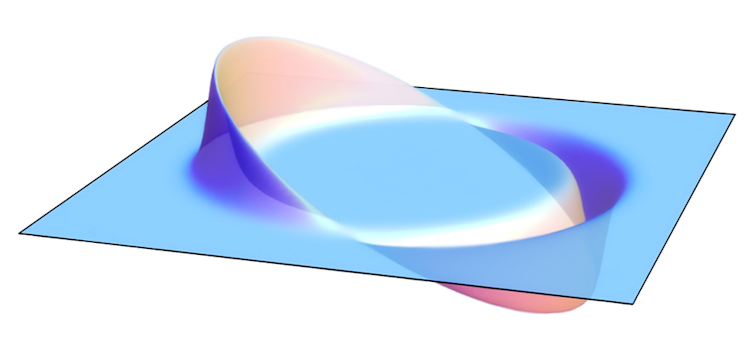
Compression and expansion
Physicists’ current understanding of spacetime comes from Albert Einstein’s theory of General Relativity . General Relativity states that space and time are fused and that nothing can travel faster than the speed of light. General relativity also describes how mass and energy warp spacetime – hefty objects like stars and black holes curve spacetime around them. This curvature is what you feel as gravity and why many spacefaring heroes worry about “getting stuck in” or “falling into” a gravity well. Early science fiction writers John Campbell and Asimov saw this warping as a way to skirt the speed limit.
What if a starship could compress space in front of it while expanding spacetime behind it? “Star Trek” took this idea and named it the warp drive.
In 1994, Miguel Alcubierre, a Mexican theoretical physicist, showed that compressing spacetime in front of the spaceship while expanding it behind was mathematically possible within the laws of General Relativity . So, what does that mean? Imagine the distance between two points is 10 meters (33 feet). If you are standing at point A and can travel one meter per second, it would take 10 seconds to get to point B. However, let’s say you could somehow compress the space between you and point B so that the interval is now just one meter. Then, moving through spacetime at your maximum speed of one meter per second, you would be able to reach point B in about one second. In theory, this approach does not contradict the laws of relativity since you are not moving faster than light in the space around you. Alcubierre showed that the warp drive from “Star Trek” was in fact theoretically possible.
Proxima Centauri here we come, right? Unfortunately, Alcubierre’s method of compressing spacetime had one problem: it requires negative energy or negative mass.
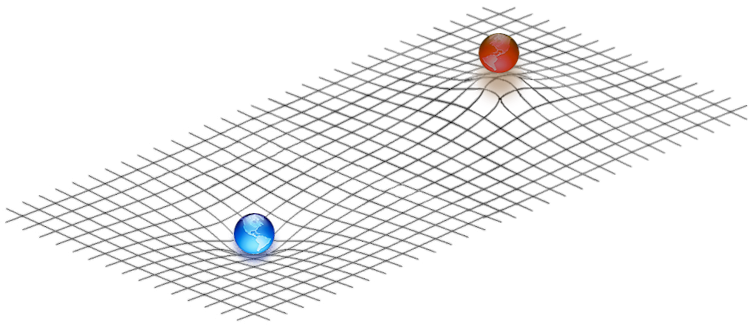
A negative energy problem
Alcubierre’s warp drive would work by creating a bubble of flat spacetime around the spaceship and curving spacetime around that bubble to reduce distances. The warp drive would require either negative mass – a theorized type of matter – or a ring of negative energy density to work. Physicists have never observed negative mass, so that leaves negative energy as the only option.
To create negative energy, a warp drive would use a huge amount of mass to create an imbalance between particles and antiparticles. For example, if an electron and an antielectron appear near the warp drive, one of the particles would get trapped by the mass and this results in an imbalance. This imbalance results in negative energy density. Alcubierre’s warp drive would use this negative energy to create the spacetime bubble.
But for a warp drive to generate enough negative energy, you would need a lot of matter. Alcubierre estimated that a warp drive with a 100-meter bubble would require the mass of the entire visible universe .
In 1999, physicist Chris Van Den Broeck showed that expanding the volume inside the bubble but keeping the surface area constant would reduce the energy requirements significantly , to just about the mass of the sun. A significant improvement, but still far beyond all practical possibilities.
A sci-fi future?
Two recent papers – one by Alexey Bobrick and Gianni Martire and another by Erik Lentz – provide solutions that seem to bring warp drives closer to reality.
Bobrick and Martire realized that by modifying spacetime within the bubble in a certain way, they could remove the need to use negative energy. This solution, though, does not produce a warp drive that can go faster than light.
[ Over 100,000 readers rely on The Conversation’s newsletter to understand the world. Sign up today .]
Independently, Lentz also proposed a solution that does not require negative energy. He used a different geometric approach to solve the equations of General Relativity, and by doing so, he found that a warp drive wouldn’t need to use negative energy. Lentz’s solution would allow the bubble to travel faster than the speed of light.
It is essential to point out that these exciting developments are mathematical models. As a physicist, I won’t fully trust models until we have experimental proof. Yet, the science of warp drives is coming into view. As a science fiction fan, I welcome all this innovative thinking. In the words of Captain Picard , things are only impossible until they are not.
- General Relativity
- Theoretical physics
- Interstellar
- Speed of light
- Albert Einstein

Events and Communications Coordinator

Assistant Editor - 1 year cadetship

Executive Dean, Faculty of Health

Lecturer/Senior Lecturer, Earth System Science (School of Science)

Sydney Horizon Educators (Identified)
We have completed maintenance on Astronomy.com and action may be required on your account. Learn More

- Login/Register
- Solar System
- Exotic Objects
- Upcoming Events
- Deep-Sky Objects
- Observing Basics
- Telescopes and Equipment
- Astrophotography
- Space Exploration
- Human Spaceflight
- Robotic Spaceflight
- The Magazine
Warp drives: Physicists investigate faster-than-light space travel
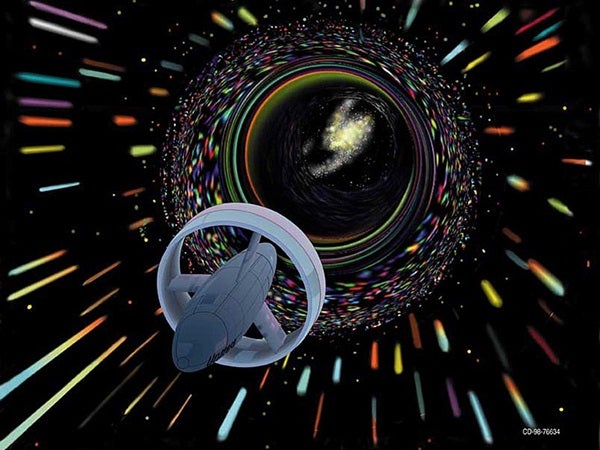
The closest star to Earth is Proxima Centauri. It is about 4.25 light-years away, or about 25 trillion miles (40 trillion kilometers). The fastest ever spacecraft, the now- in-space Parker Solar Probe will reach a top speed of 450,000 mph. It would take just 20 seconds to go from Los Angeles to New York City at that speed, but it would take the solar probe about 6,633 years to reach Earth’s nearest neighboring solar system.
If humanity ever wants to travel easily between stars, people will need to go faster than light. But so far, faster-than-light travel is possible only in science fiction.
In Issac Asimov’s Foundation series , humanity can travel from planet to planet, star to star or across the universe using jump drives. As a kid, I read as many of those stories as I could get my hands on. I am now a theoretical physicist and study nanotechnology, but I am still fascinated by the ways humanity could one day travel in space.
Some characters – like the astronauts in the movies “Interstellar” and “Thor” – use wormholes to travel between solar systems in seconds. Another approach – familiar to “Star Trek” fans – is warp drive technology. Warp drives are theoretically possible if still far-fetched technology. Two recent papers made headlines in March when researchers claimed to have overcome one of the many challenges that stand between the theory of warp drives and reality.
But how do these theoretical warp drives really work? And will humans be making the jump to warp speed anytime soon?
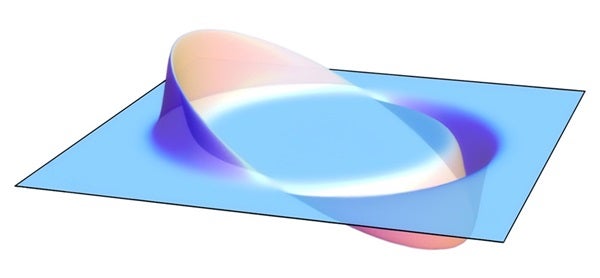
Compression and expansion
Physicists’ current understanding of spacetime comes from Albert Einstein’s theory of general relativity . General relativity states that space and time are fused and that nothing can travel faster than the speed of light. General relativity also describes how mass and energy warp spacetime – hefty objects like stars and black holes curve spacetime around them. This curvature is what you feel as gravity and why many spacefaring heroes worry about “getting stuck in” or “falling into” a gravity well. Early science fiction writers John Campbell and Asimov saw this warping as a way to skirt the speed limit.
What if a starship could compress space in front of it while expanding spacetime behind it? “Star Trek” took this idea and named it the warp drive.
In 1994, Miguel Alcubierre, a Mexican theoretical physicist, showed that compressing spacetime in front of the spaceship while expanding it behind was mathematically possible within the laws of General Relativity . So, what does that mean? Imagine the distance between two points is 33 feet (10 meters). If you are standing at point A and can travel one meter per second, it would take 10 seconds to get to point B. However, let’s say you could somehow compress the space between you and point B so that the interval is now just one meter. Then, moving through spacetime at your maximum speed of one meter per second, you would be able to reach point B in about one second. In theory, this approach does not contradict the laws of relativity since you are not moving faster than light in the space around you. Alcubierre showed that the warp drive from “Star Trek” was in fact theoretically possible.
Proxima Centauri here we come, right? Unfortunately, Alcubierre’s method of compressing spacetime had one problem: it requires negative energy or negative mass.
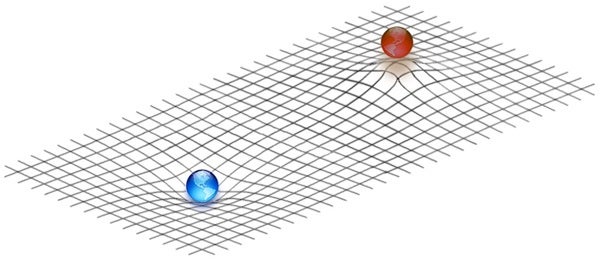
A negative energy problem
Alcubierre’s warp drive would work by creating a bubble of flat spacetime around the spaceship and curving spacetime around that bubble to reduce distances. The warp drive would require either negative mass – a theorized type of matter – or a ring of negative energy density to work. Physicists have never observed negative mass, so that leaves negative energy as the only option.
To create negative energy, a warp drive would use a huge amount of mass to create an imbalance between particles and antiparticles. For example, if an electron and an antielectron appear near the warp drive, one of the particles would get trapped by the mass and this results in an imbalance. This imbalance results in negative energy density. Alcubierre’s warp drive would use this negative energy to create the spacetime bubble.
But for a warp drive to generate enough negative energy, you would need a lot of matter. Alcubierre estimated that a warp drive with a 100-meter bubble would require the mass of the entire visible universe .
In 1999, physicist Chris Van Den Broeck showed that expanding the volume inside the bubble but keeping the surface area constant would reduce the energy requirements significantly , to just about the mass of the Sun. A significant improvement, but still far beyond all practical possibilities.
A sci-fi future?
Two recent papers – one by Alexey Bobrick and Gianni Martire and another by Erik Lentz – provide solutions that seem to bring warp drives closer to reality.
Bobrick and Martire realized that by modifying spacetime within the bubble in a certain way, they could remove the need to use negative energy. This solution, though, does not produce a warp drive that can go faster than light.
Independently, Lentz also proposed a solution that does not require negative energy. He used a different geometric approach to solve the equations of general relativity, and by doing so, he found that a warp drive wouldn’t need to use negative energy. Lentz’s solution would allow the bubble to travel faster than the speed of light.
It is essential to point out that these exciting developments are mathematical models. As a physicist, I won’t fully trust models until we have experimental proof. Yet, the science of warp drives is coming into view. As a science fiction fan, I welcome all this innovative thinking. In the words of Captain Picard , things are only impossible until they are not.
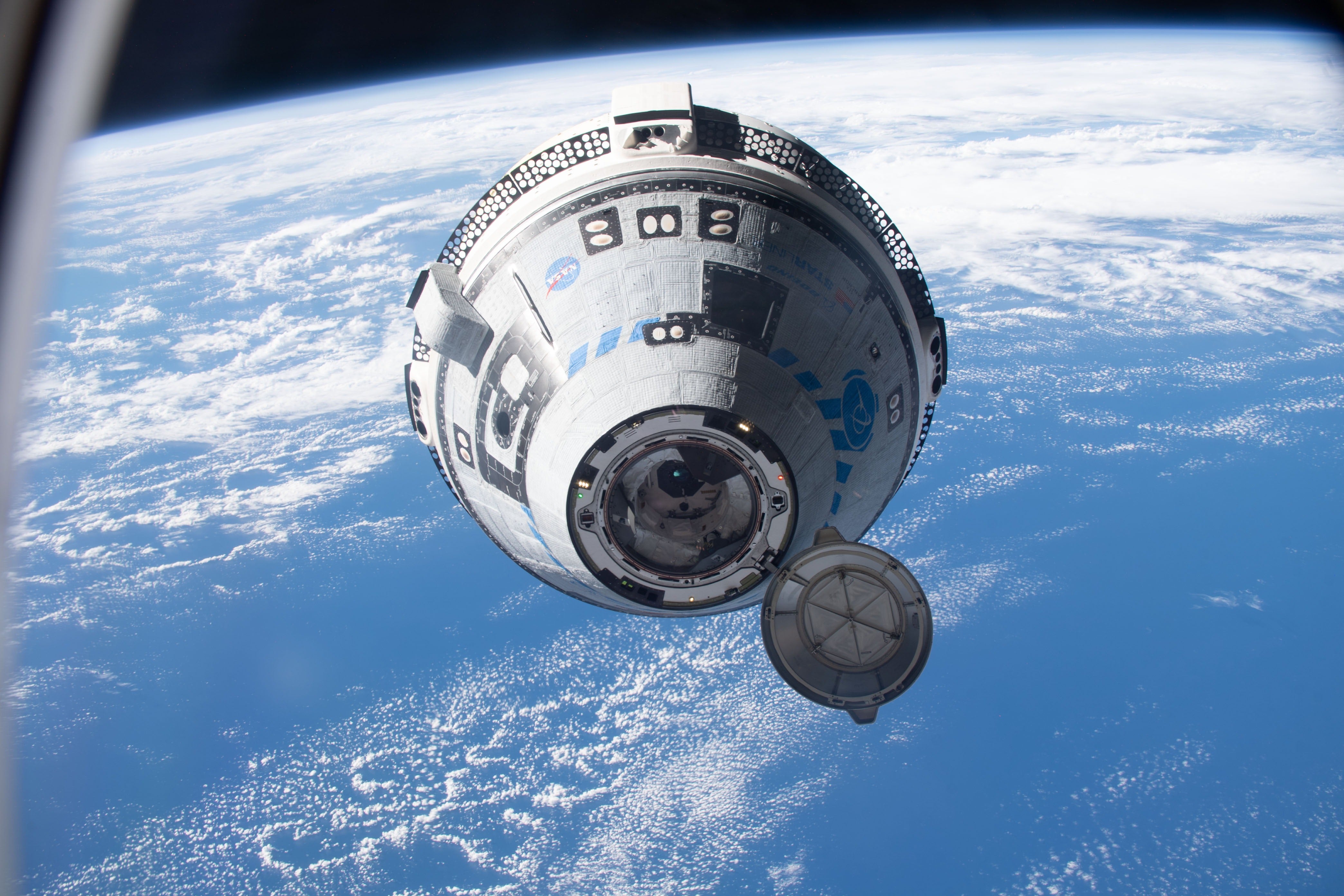
Boeing’s Starliner launch – delayed again – will be an important milestone for commercial spaceflight
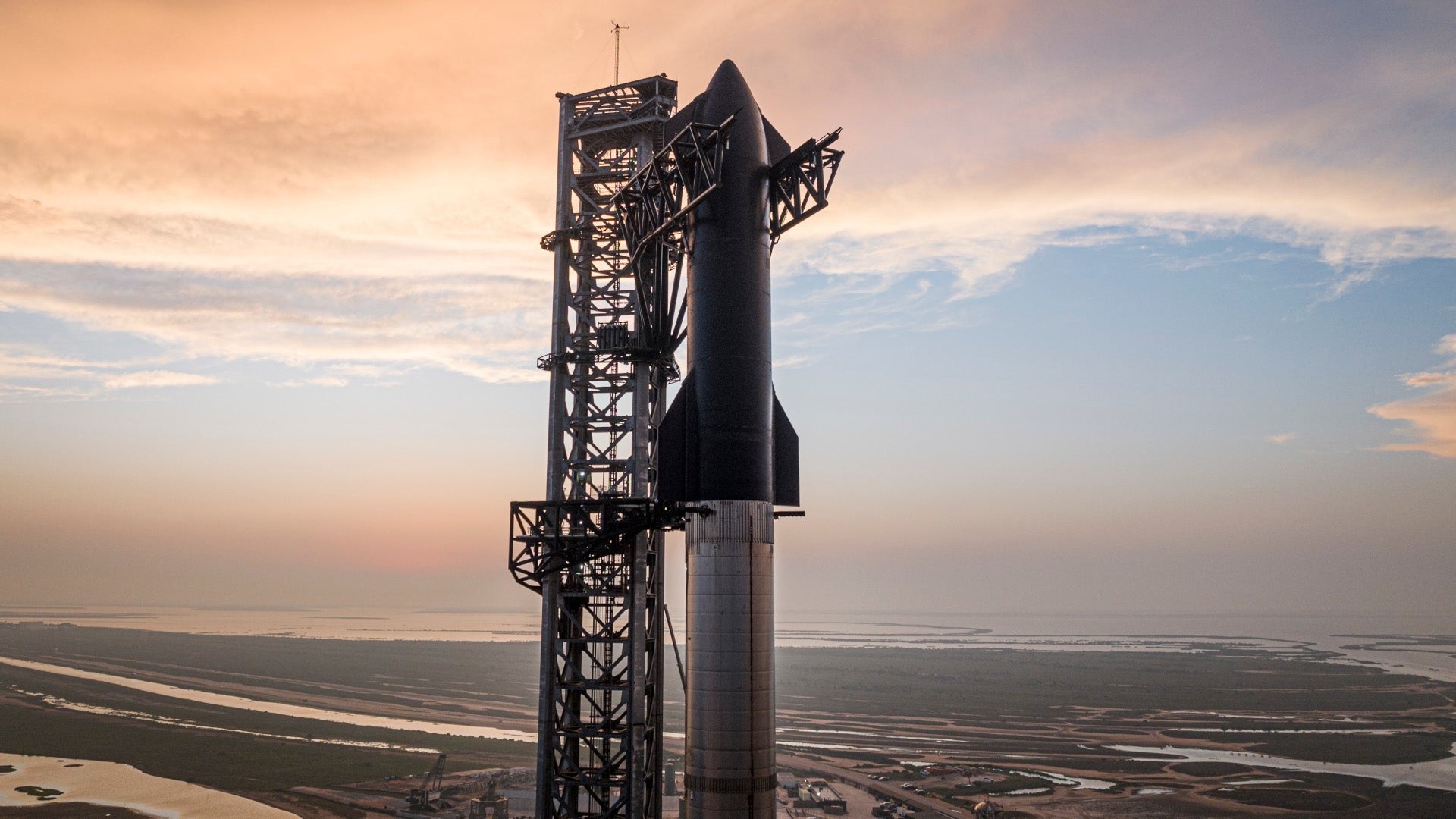
SpaceX adds tourism offering to website
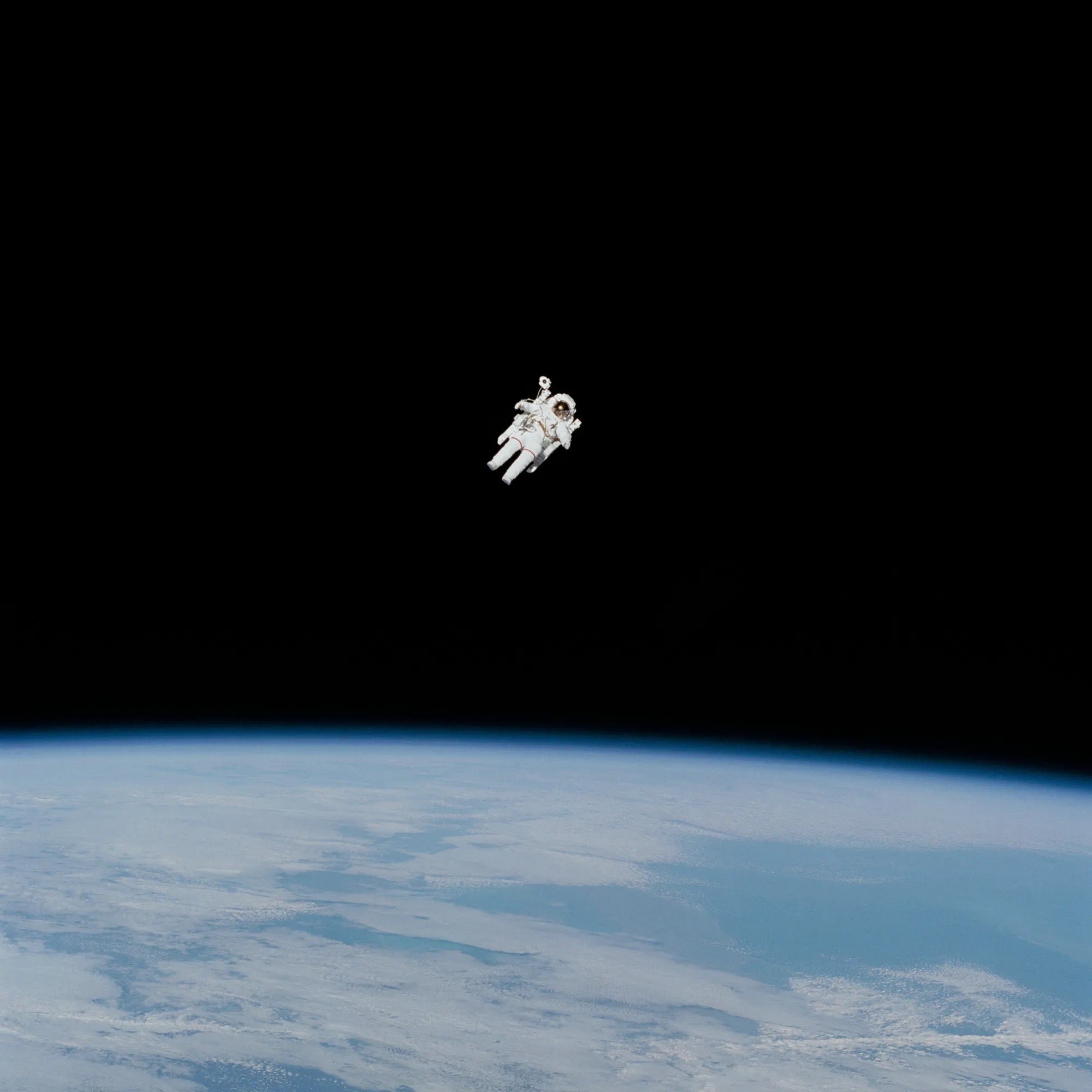
Astronauts have a surprising ability to gauge distances in space
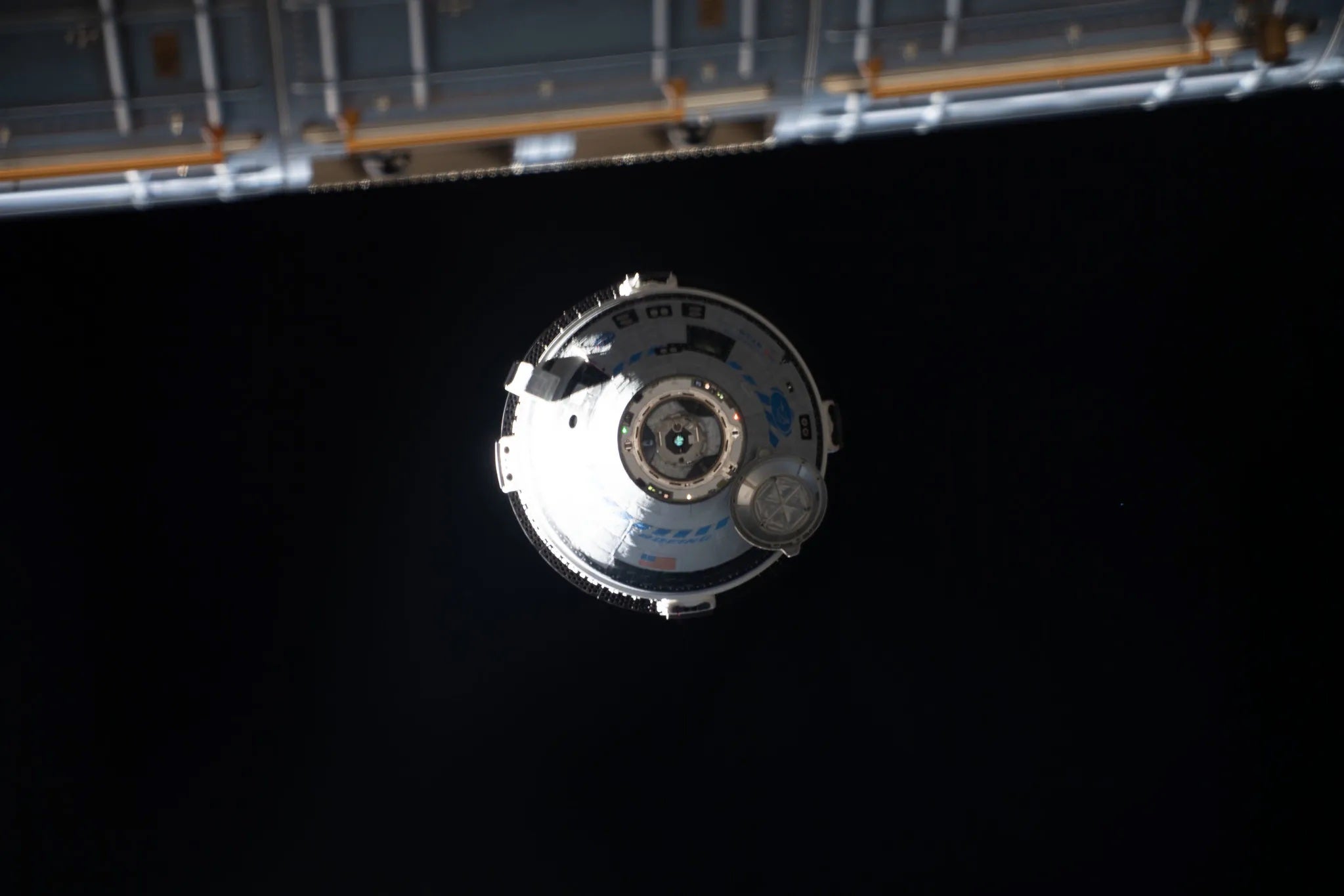
The NASA/Boeing Starliner launches soon. Here’s what to know.

What happens if someone dies in space?

Meet Katya Echazarreta, the first Mexican-born woman to travel to space

A metal chunk that burst through a Florida home came from the ISS

An updated list of space missions: Current and upcoming voyages

NASA bids farewell to the Ingenuity Mars Helicopter with new photos
'Warp drives' may actually be possible someday, new study suggests
"By demonstrating a first-of-its-kind model, we've shown that warp drives might not be relegated to science fiction."

A new study provides some theoretical underpinning to warp drives, suggesting that the superfast propulsion tech may not forever elude humanity.
Sci-fi fans — especially " Star Trek " devotees — are familiar with warp drives . These hypothetical engines manipulate the fabric of space-time itself, compressing the stuff in front of a spaceship and expanding it behind. This creates a "warp bubble" that allows a craft to travel at incredible velocities — in some imaginings, many times faster than the speed of light .
In 1994, Mexican physicist Miguel Alcubierre published a groundbreaking paper that laid out how a real-life warp drive could work. This exciting development came with a major caveat, however: The proposed "Alcubierre drive" required negative energy, an exotic substance that may or may not exist (or, perhaps, the harnessing of dark energy , the mysterious force that seems to be causing the universe's accelerated expansion).
Related: Warp drive and 'Star Trek': The physics of future space travel
Alcubierre published his idea in Classical and Quantum Gravity. Now, a new paper in the same journal suggests that a warp drive may not require exotic negative energy after all.
"This study changes the conversation about warp drives," lead author Jared Fuchs, of the University of Alabama, Huntsville and the research think tank Applied Physics, said in a statement. "By demonstrating a first-of-its-kind model, we've shown that warp drives might not be relegated to science fiction."
The team's model uses "a sophisticated blend of traditional and novel gravitational techniques to create a warp bubble that can transport objects at high speeds within the bounds of known physics," according to the statement.
Get the Space.com Newsletter
Breaking space news, the latest updates on rocket launches, skywatching events and more!
Understanding that model is probably beyond most of us; the paper's abstract, for example, says that the solution "involves combining a stable matter shell with a shift vector distribution that closely matches well-known warp drive solutions such as the Alcubierre metric."
The proposed engine could not achieve faster-than-light travel, though it could come close; the statement mentions "high but subluminal speeds."
— How 'Star Trek' technology works (infographic)
— Warp speed: The hype of hyperspace
— What is dark energy?
This is a single modeling study, so don't get too excited. Even if other research teams confirm that the math reported in the new study checks out, we're still very far from being able to build an actual warp drive.
Fuchs and his team admit as much, stressing that their work could end up being a stepping stone on the long road to efficient interstellar flight.
"While we're not yet preparing for interstellar voyages, this research heralds a new era of possibilities," Gianni Martire, CEO of Applied Physics, said in the same statement. "We're continuing to make steady progress as humanity embarks on the Warp Age."
The team's study was published online on April 29. You can find it here , though all but the abstract is behind a paywall; a free preprint version is available via arXiv.org.
Join our Space Forums to keep talking space on the latest missions, night sky and more! And if you have a news tip, correction or comment, let us know at: [email protected].

Michael Wall is a Senior Space Writer with Space.com and joined the team in 2010. He primarily covers exoplanets, spaceflight and military space, but has been known to dabble in the space art beat. His book about the search for alien life, "Out There," was published on Nov. 13, 2018. Before becoming a science writer, Michael worked as a herpetologist and wildlife biologist. He has a Ph.D. in evolutionary biology from the University of Sydney, Australia, a bachelor's degree from the University of Arizona, and a graduate certificate in science writing from the University of California, Santa Cruz. To find out what his latest project is, you can follow Michael on Twitter.
Lego Marvel The Amazing Spider-Man review
Lego Star Wars Millennium Falcon (2024) review
Boeing's Starliner rolled off launch pad to replace 'buzzing' rocket valve (photo)
- MikeEz I would be interested in Dr. Alcubierre and Dr. Whites' responses. Reply
- billslugg It uses standard physics and does not allow FTL travel, according to the article. What's the point? Reply
- Questioner I think what they are saying is it creates an independent frame of reference. That it is dislodged from standard spatial continuity. That would be the first step to superluminal Alcubierri methodology. It also might evade luminal proximate collisions with space detrimous. But that's just my take. Reply
- Pogo We’ve been launching stuff beyond Earth’s atmosphere for 67 years now and haven’t gotten beyond 0.064c thus far. This warp thing is still only one team’s theory. It’ll likely be generations before we get even a subatomic particle into this warp speed thing, if ever. If it ever does become practical, it could be used to send small probes to local stars in a reasonable timeline. Anything manned will not likely be practical. The article doesn’t mention if warp drive actually negates relativistic effects. Reply
- billslugg All of the theories that would have us go FTL are based on solutions to Einstein's field equations. That they solve the equations does not necessarily mean they can exist in reality. Here is an example: The area of a square is given by x^2. Two negative numbers can solve the equation just as well as two positive numbers can. But there is no such thing as negative length. Headline: "Scientists find solution to area problem that involves negative length, thus it must exist". Another reason we can't go FTL. If one goes FTL, one must necessarily pass through c. At that point, the item would require all of the mass in the universe be converted into its kinetic energy. In other words: "You can't get there from here". Reply
billslugg said: It uses standard physics and does not allow FTL travel, according to the article. What's the point?
- billslugg Valid points. When they actually come up with some of the exotic matter they need, then I'll get on board. Reply
Pogo said: The article doesn’t mention if warp drive actually negates relativistic effects.
Mizagorn said: That was my first thought. You're part of the crew. You get paid by the hour and you're on the clock. Do you go by the onboard clock or the one back at the office? 🤔
Admin said: A new study provides some theoretical underpinning to sci-fi warp drives, suggesting that the superfast propulsion tech may not forever elude humanity. Warp drives' may actually be possible someday, new study suggests : Read more
- View All 24 Comments
Most Popular
- 2 A failed star and an ammonia trail could reveal how some giant exoplanets form
- 3 World's largest visible light telescope spies a galaxy cluster warping spacetime
- 4 SpaceX launching 20 satellites from California tonight on 2nd leg of Starlink doubleheader
- 5 Star Wars makes Darth Jar Jar official in 'Lego Star Wars: Rebuild the Galaxy' mini-series (video)
- Follow us on Facebook
- Follow us on Twitter
- Follow us on LinkedIn
- Watch us on Youtube
- Latest Explore all the latest news and information on Physics World
- Research updates Keep track of the most exciting research breakthroughs and technology innovations
- News Stay informed about the latest developments that affect scientists in all parts of the world
- Features Take a deeper look at the emerging trends and key issues within the global scientific community
- Opinion and reviews Find out whether you agree with our expert commentators
- Interviews Discover the views of leading figures in the scientific community
- Analysis Discover the stories behind the headlines
- Blog Enjoy a more personal take on the key events in and around science
- Physics World Live
- Impact Explore the value of scientific research for industry, the economy and society
- Events Plan the meetings and conferences you want to attend with our comprehensive events calendar
- Innovation showcases A round-up of the latest innovation from our corporate partners
- Collections Explore special collections that bring together our best content on trending topics
- Artificial intelligence Explore the ways in which today’s world relies on AI, and ponder how this technology might shape the world of tomorrow
- #BlackInPhysics Celebrating Black physicists and revealing a more complete picture of what a physicist looks like
- Nanotechnology in action The challenges and opportunities of turning advances in nanotechnology into commercial products
- The Nobel Prize for Physics Explore the work of recent Nobel laureates, find out what happens behind the scenes, and discover some who were overlooked for the prize
- Revolutions in computing Find out how scientists are exploiting digital technologies to understand online behaviour and drive research progress
- The science and business of space Explore the latest trends and opportunities associated with designing, building, launching and exploiting space-based technologies
- Supercool physics Experiments that probe the exotic behaviour of matter at ultralow temperatures depend on the latest cryogenics technology
- Women in physics Celebrating women in physics and their contributions to the field
- Audio and video Explore the sights and sounds of the scientific world
- Podcasts Our regular conversations with inspiring figures from the scientific community
- Video Watch our specially filmed videos to get a different slant on the latest science
- Webinars Tune into online presentations that allow expert speakers to explain novel tools and applications
- IOP Publishing
- Enter e-mail address
- Show Enter password
- Remember me Forgot your password?
- Access more than 20 years of online content
- Manage which e-mail newsletters you want to receive
- Read about the big breakthroughs and innovations across 13 scientific topics
- Explore the key issues and trends within the global scientific community
- Choose which e-mail newsletters you want to receive
Reset your password
Please enter the e-mail address you used to register to reset your password
Registration complete
Thank you for registering with Physics World If you'd like to change your details at any time, please visit My account
- Astronomy and space
- Research update
Spacecraft in a ‘warp bubble’ could travel faster than light, claims physicist
Albert Einstein’s special theory of relativity famously dictates that no known object can travel faster than the speed of light in vacuum, which is 299,792 km/s. This speed limit makes it unlikely that humans will ever be able to send spacecraft to explore beyond our local area of the Milky Way.
However, new research by Erik Lentz at the University of Göttingen suggests a way beyond this limit. The catch is that his scheme requires vast amounts of energy and it may not be able to propel a spacecraft.
Lentz proposes that conventional energy sources could be capable of arranging the structure of space–time in the form of a soliton – a robust singular wave. This soliton would act like a “warp bubble’”, contracting space in front of it and expanding space behind. Unlike objects within space–time, space–time itself can bend, expand or warp at any speed. Therefore, a spacecraft contained in a hyperfast bubble could arrive at its destination faster than light would in normal space without breaking any physical laws, even Einstein’s cosmic speed limit.
Negative energy
The idea of creating warp bubbles is not new, it was first proposed in 1994 by the Mexican physicist Miguel Alcubierre who dubbed them “warp drives” in homage to the sci-fi series Star Trek . However, until Lentz’s research it was thought that the only way to produce a warp drive was by generating vast amounts of negative energy – perhaps by using some sort of undiscovered exotic matter or by the manipulation of dark energy. To get around this problem, Lentz constructed an unexplored geometric structure of space–time to derive a new family of solutions to Einstein’s general relativity equations called positive-energy solitons.
Though Lentz’s solitons appear to conform to Einstein’s general theory of relativity and remove the need to create negative energy, space agencies will not be building warp drives any time soon, if ever. Part of the reason is that Lentz’s positive-energy warp drive requires a huge amount of energy. A 100 m radius spacecraft would require the energy equivalent to “hundreds of times of the mass of the planet Jupiter”, according to Lentz. He adds that to be practical, this requirement would have to be reduced by about 30 orders of magnitude to be on par with the output of a modern nuclear fission reactor. Lentz is currently exploring existing energy-saving schemes to see if the energy required can be reduced to a practical level.
Any warp drive would also need to overcome several other serious issues. Alcubierre, who regards Lentz’s work as a “significant development”, cites the “horizon problem” as one of the most pernicious. “A warp bubble travelling faster than light cannot be created from inside the bubble, as the leading edge of the bubble would be beyond the reach of a spaceship sitting at its centre,” he explains. “The problem is that you need energy to deform space all the way to the very edge of the bubble, and the ship simply can’t put it there.”
Spacecraft doubts
Lentz describes his calculations in Classical and Quantum Gravity , where other recent research on the topic is outlined in an accepted manuscript from Advanced Propulsion Laboratory researchers Alexey Bobrick and Gianni Martire. The duo describes a general model for a warp drive incorporating all existing positive-energy and negative-energy warp drive schemes, except Lentz’s which they say “likely forms a new class of warp drive space–times”.
However, they argue that a Lentz-type warp drive is like any other type of warp drive in the sense that, at its core, it is a shell of regular material and therefore subject to Einstein’s cosmic speed limit, concluding that “there is no known way of accelerating a warp drive beyond the speed of light”.

Ad astra! To the stars!
Though he recognizes these huge hurdles to building a warp drive, Lentz feels they are not insurmountable. “This work has moved the problem of faster-than-light travel one step away from theoretical research in fundamental physics and closer to engineering,” he says.
After addressing energy requirements, Lentz plans to “devise a means of creating and accelerating (and dissipating and decelerating) the positive-energy solitons from their constituent matter sources”, then confirm the existence of small and slow solitons in a laboratory, and finally address the horizon problem. “This will be important to passing the speed of light with a fully autonomous soliton,” he says.
Want to read more?
- E-mail Address
Benjamin Skuse is a science writer based in Somerset, UK

Physics World Jobs
Take the next step in your career and find your perfect job
- Nanomedicine
Nanoparticle-based vaccine offers new approach to COVID-19 immunity
- Quantum mechanics
Quantum mechanics gives new insights into the Gibbs paradox
Discover more from physics world.
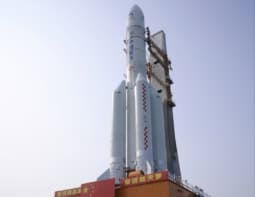
China launches Chang’e-6 mission to return samples from the Moon’s far side
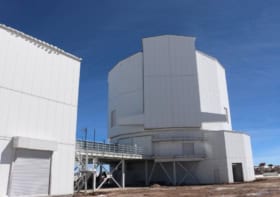
World’s highest observatory begins operations in Chile

- Telescopes and space missions
From pulsars and fast radio bursts to gravitational waves and beyond: a family quest for Maura McLaughlin and Duncan Lorimer
Related jobs, faculty position in theoretical physics (lecturer in extrasolar planets), assistant, associate, or full project scientist in physics, director of the astrophysics cross-observatory science support (across) initiative, related events.
- Astronomy and space | Conference SPIE Astronomical Telescopes + Instrumentation 2024 16—21 June 2024 | Yokohama, Japan
- Particle and nuclear | Symposium Fifth International Symposium on the Casimir Effect 15—21 September 2024 | Piran, Slovenia
- Astronomy and space | Conference Seventh International Conference on the Nature and Ontology of Spacetime 16—19 September 2024 | Albena, Bulgaria

- May 7, 2024 | Did the Webb Telescope Find Alien Life on Exoplanet K2-18b? Here’s What We Know
- May 7, 2024 | Transformative Discovery Could Solve Billion-Dollar Problem of Poorly Managed Wound Healing
- May 7, 2024 | Rare Retinal Cells May Hold the Key to True Color Perception
- May 7, 2024 | A New Frontier in Chemistry: Roaming Reactions Shatter Old Assumptions
- May 7, 2024 | Cold Case: Scientific Sleuths Solve the Case of the Mysterious Giant Opening in Antarctic Sea Ice
Breaking the Warp Barrier for Faster-Than-Light Travel: New Theoretical Hyper-Fast Solitons Discovered
By University of Göttingen March 11, 2021

Artistic impression of different spacecraft designs considering theoretical shapes of different kinds of “warp bubbles.” Credit: E Lentz
Astrophysicist at Göttingen University discovers new theoretical hyper-fast soliton solutions.
If travel to distant stars within an individual’s lifetime is going to be possible, a means of faster-than-light propulsion will have to be found. To date, even recent research about superluminal (faster-than-light) transport based on Einstein’s theory of general relativity would require vast amounts of hypothetical particles and states of matter that have “exotic” physical properties such as negative energy density. This type of matter either cannot currently be found or cannot be manufactured in viable quantities. In contrast, new research carried out at the University of Göttingen gets around this problem by constructing a new class of hyper-fast ‘solitons’ using sources with only positive energies that can enable travel at any speed. This reignites debate about the possibility of faster-than-light travel based on conventional physics. The research is published in the journal Classical and Quantum Gravity.
The author of the paper, Dr. Erik Lentz, analyzed existing research and discovered gaps in previous ‘warp drive’ studies. Lentz noticed that there existed yet-to-be explored configurations of space-time curvature organized into ‘solitons’ that have the potential to solve the puzzle while being physically viable. A soliton – in this context also informally referred to as a ‘warp bubble’ – is a compact wave that maintains its shape and moves at constant velocity. Lentz derived the Einstein equations for unexplored soliton configurations (where the space-time metric’s shift vector components obey a hyperbolic relation), finding that the altered space-time geometries could be formed in a way that worked even with conventional energy sources. In essence, the new method uses the very structure of space and time arranged in a soliton to provide a solution to faster-than-light travel, which – unlike other research – would only need sources with positive energy densities. No “exotic” negative energy densities needed.
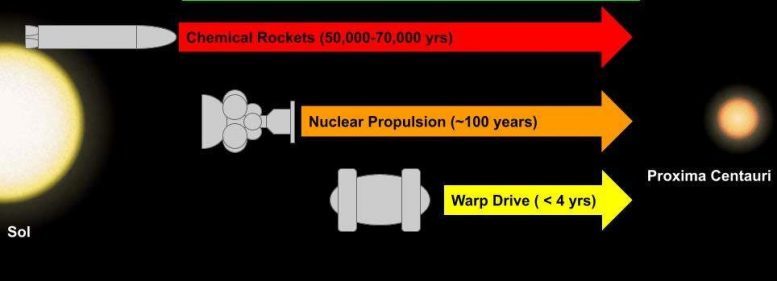
Image to show how long it would take different types of spacecraft to travel from our solar system to Proxima Centauri (the nearest known star). Currently, the only option would be to use a chemical rocket meaning a journey time of over 50,000 years. Credit: E Lentz
If sufficient energy could be generated, the equations used in this research would allow space travel to Proxima Centauri, our nearest star, and back to Earth in years instead of decades or millennia. That means an individual could travel there and back within their lifetime. In comparison, the current rocket technology would take more than 50,000 years for a one-way journey. In addition, the solitons (warp bubbles) were configured to contain a region with minimal tidal forces such that the passing of time inside the soliton matches the time outside: an ideal environment for a spacecraft. This means there would not be the complications of the so-called “twin paradox” whereby one twin traveling near the speed of light would age much more slowly than the other twin who stayed on Earth: in fact, according to the recent equations both twins would be the same age when reunited.
“This work has moved the problem of faster-than-light travel one step away from theoretical research in fundamental physics and closer to engineering. The next step is to figure out how to bring down the astronomical amount of energy needed to within the range of today’s technologies, such as a large modern nuclear fission power plant. Then we can talk about building the first prototypes,” says Lentz.
Currently, the amount of energy required for this new type of space propulsion drive is still immense. Lentz explains, “The energy required for this drive traveling at light speed encompassing a spacecraft of 100 meters in radius is on the order of hundreds of times of the mass of the planet Jupiter . The energy savings would need to be drastic, of approximately 30 orders of magnitude to be in range of modern nuclear fission reactors.” He goes on to say: “Fortunately, several energy-saving mechanisms have been proposed in earlier research that can potentially lower the energy required by nearly 60 orders of magnitude.” Lentz is currently in the early-stages of determining if these methods can be modified, or if new mechanisms are needed to bring the energy required down to what is currently possible.
Reference: “Breaking the warp barrier: hyper-fast solitons in Einstein–Maxwell- plasma theory” by Erik W Lentz, 9 March 2021, Classical and Quantum Gravity . DOI: 10.1088/1361-6382/abe692
More on SciTechDaily
Quantum magic squares cannot be as easily characterized as their “classical” cousins.

Can We Make Opioids Less Addictive? [Video]

Meltwater Pulse 1A: Melting Ice Sheets Caused Sea Levels to Rise Up to 18 Meters

Stromatolites – Fossils of Earliest Life on Earth – May Owe Their Very Existence to Viruses

Giant Millipedes “As Big as Cars” Once Roamed Northern England – “Complete Fluke of a Discovery”
Did a black hole eating a star generate a neutrino new research casts doubt.

America Must Prepare for COVID-19 Related Drug Shortages
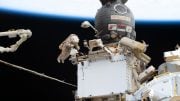

Cosmonauts Begin Spacewalk To Move Roscosmos Radiator on Space Station
22 comments on "breaking the warp barrier for faster-than-light travel: new theoretical hyper-fast solitons discovered".
“Sufficient Energy” This already exist in the form of Element 115. If the Unauthorized Black Projects are ever revealed, word on the grapevine says its actually instantaneous. Lets go to Alpha Centaur i.
If we had that kind of energy on earth, everyone would know.
If only because that much energy in one place would have as much gravity as Jupiter.
Proposed mechanism is a propagation of a distortion of spacetime of a particular form. Thus it is ultimately very much like propagation of gravitational waves. However gravitational waves propagate with speed of light. Therefore I don’t see how it may be possible.
“Take us Out… Chekov”
The biggest form of untapped energy is at rest and stable energy. We only think of energy in it’s transitions. If we would convert the energy of stable space it is limitless.
Useful work of any kind has always, not only by man but by nature as well, only been accomplishable by exploiting an energy gradient (i.e. harnessing the movement of energy from where it is plentiful to where it is scarce). That’s what entropy is.
Find a way around that and we won’t *need* warp drives, we can simply create anything and everything we could ever want from nothing, forever.
You mean element 151…
IDK. I think it is about TIME… to find a horse of a different color. The protocols heron defined have “designed” a wonderful “horseshoe” (RELATIVELY speaking) and are busy trying to fit it to an elephant just because it’s in the ROOM: where time and space are limited… TIME to leave the womb… er… ROOM. Which is to say: Star Trekking is a fantasy, a phantasm and a FICTION devised inside a “boxy” Universe, whose PHYSICS seem to conform to the BIAS of Mortality (TIME is the limiting factor). It engenders HASTE in seeking a solution: We are “on the run”, desperately looking for a way to boldly go where no HUMAN has gone before. Good LUCK with that. Back to the Horseshoe, in want of a “NAIL”. As DANTE writ above the GATES of Hell: “Abandon ye all HOPE who enter here:” Where strayeth the MIND the FEET will follow. But it’s not about Feet, or Miles or Light Years. SINGULARITIES ALL: Infinite acceleration = Infinite ENTROPY. One is effectively DEAD in the water, while the proverbial WORM in the HOLE has a feast. It’s about standing still in the STREAM of Time, while SPACE flows on around ONE: A STREAM where the banks are in motion as well. It’s about being IN the FIELD and NOT UNDER IT. No need for flesh-liquifying SPEED. Think about it… In the meantime, ring up ACME Fireworks Inc. Ask for the “Wile E Coyote” Package. Next stop: Alpha CENTAURI… now passing URANUS on the way out of here. WARP NINE MISTER WARF. MAKE IT SO. Walk the World Round and wind up where you started from. FEET again. It is the ultimate Circular Argument of Intent in a two-dimensional UNIVERSE, OUTSIDE of TIME. The FABRIC of a DREAM…
A very small craft might be fitted with a very high power drive. A craft of 100m radius is mentioned. Eventually we will miniaturize the craft.
I totally agree with you because no way would time ever change no matter how much energy is used in traveling. The most important aspect of this research as I’m working on is understanding hot and cold. Gravity and acceleration of planet and stars to then making a mechanism that can trick the universe into believing the mechanism behavior is indeed faster heavier or lighter then what would be expected for such a device on Earth. Artificial takes new meaning with my studies and I wish you all the best likewise.
Warp drive or not we are not ready until we are one we will never understand we will never be welcomed to intelligent beyond earth I believe ther are watching.
At the present time nothing is faster than light, but there is! It’s always been here watch! The Sun’s light takes about 8 minutes to arrive to earth. If I (THINK) about the sun to earth I have beat the light travel. Human thought is faster than light. Just for thought. Now let’s get down to business. WARP DRIVE can be achieved. Anti-gravity is negative energy. Loaded in darkness of space. What u need in space is large amounts of gravity to pull or accelerate. Warp Drive is a push pull in a sense. A laser SCOPE can achieve this. Space/time bends light as u know, riding on a laser beam moving to a point of reference (sun) gives u the positive gravity neccessary inside the bubble to move. In theory the light is behind you. Still within einstein’s theory.more to say later see ya
The illustration atop this page is an excellent example of WHY artists impressions are NOT useful is the discussion of science.
Put most simply : there is no data, yet there IS an illustration… of SOMETHING, that means nothing. What is there to learn from this?
We Warp Drive manufacturing, our fission-annihilation antigravity propulsion accelerate to lightspeed, but by nuclear annihilation reaction generate high-density time-space, so from outside observation, we traveling on higher speed. The best is to travel outside of the galactic disk for maximum speed. To understand advanced physic is necessary to first understand the Theory of Relativity. Sped of light is constant only in the frame, outside dependant on the speed of time.
Chris m exactly..rest energy would be the best for getting us out of this area..it’s the ink pen vs pencil problem.spend tons of cash on writing with a pen or use a pencil for $.05.we already have the oxygen thing worked out..I say we just jump on in and figure it out as we go haha
Why not look into the idea like the Enterprise u already have this ISS up there why not try to buid a space hanger to build the ship like the Enterprise in it we have the technology to do it and while ship was getting built u cold work on the warp drive engines to power it this is the 21st century we should be thinking on lines like that im not saying theres vulcans or klingonns out there but with a ship like that we might get to see if we are alone in this galaxy or not
This would also allow for sub-light speed as well with I am assuming lesser energy requirements. Works be with losing for just to get around the solar system faster
How do we stop this spaceship?
by “breaking” the warp bubble in advance by a few nano seconds. lowering the space ship to sub light speeds temporarily.
Just traveling at light speed would be an accomplishment, yet no one talks about sailing on waves of gravity which would take much less energy. Even though warp speed is faster, we should probably walk before we run.
faster than light propulsion and anti-gravity
https://pronewsreport.com/2021/05/31/antigravity-flying-saucer-for-solar-system-exploration/
Antimatter for Antigravity and Faster than Light Propulsion
Leave a comment Cancel reply
Email address is optional. If provided, your email will not be published or shared.
Save my name, email, and website in this browser for the next time I comment.
- The Magazine
- Stay Curious
- The Sciences
- Environment
- Planet Earth
Warp Drives: Physicists Give Chances of Faster-Than-Light Space Travel a Boost
Faster than light travel is the only way humans could ever get to other stars in a reasonable amount of time..
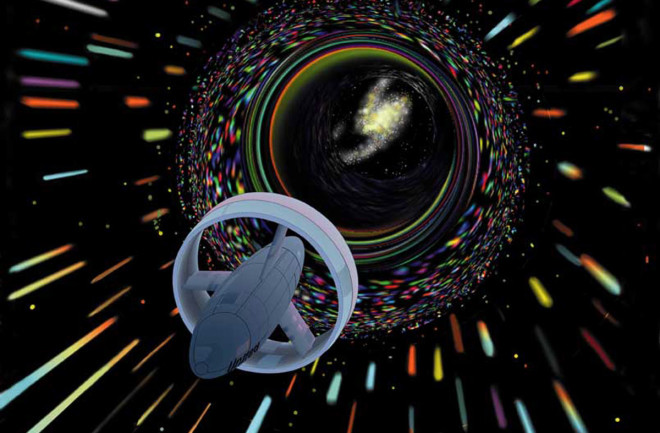
The closest star to Earth is Proxima Centauri. It is about 4.25 light-years away, or about 25 trillion miles (40 trillion km). The fastest ever spacecraft, the now-in-space Parker Solar Probe will reach a top speed of 450,000 mph. It would take just 20 seconds to go from Los Angeles to New York City at that speed, but it would take the solar probe about 6,633 years to reach Earth’s nearest neighboring solar system.
If humanity ever wants to travel easily between stars, people will need to go faster than light. But so far, faster-than-light travel is possible only in science fiction.
In Issac Asimov’s Foundation series , humanity can travel from planet to planet, star to star or across the universe using jump drives. As a kid, I read as many of those stories as I could get my hands on. I am now a theoretical physicist and study nanotechnology, but I am still fascinated by the ways humanity could one day travel in space.
Some characters – like the astronauts in the movies “Interstellar” and “Thor” — use wormholes to travel between solar systems in seconds. Another approach — familiar to “Star Trek” fans — is warp drive technology. Warp drives are theoretically possible if still far-fetched technology. Two recent papers made headlines in March when researchers claimed to have overcome one of the many challenges that stand between the theory of warp drives and reality.
But how do these theoretical warp drives really work? And will humans be making the jump to warp speed anytime soon?
Compression and Expansion
Physicists’ current understanding of spacetime comes from Albert Einstein’s theory of General Relativity . General Relativity states that space and time are fused and that nothing can travel faster than the speed of light. General relativity also describes how mass and energy warp spacetime — hefty objects like stars and black holes curve spacetime around them. This curvature is what you feel as gravity and why many spacefaring heroes worry about “getting stuck in” or “falling into” a gravity well. Early science fiction writers John Campbell and Asimov saw this warping as a way to skirt the speed limit.
What if a starship could compress space in front of it while expanding spacetime behind it? “Star Trek” took this idea and named it the warp drive.
In 1994, Miguel Alcubierre, a Mexican theoretical physicist, showed that compressing spacetime in front of the spaceship while expanding it behind was mathematically possible within the laws of General Relativity . So, what does that mean? Imagine the distance between two points is 10 meters (33 feet). If you are standing at point A and can travel one meter per second, it would take 10 seconds to get to point B. However, let’s say you could somehow compress the space between you and point B so that the interval is now just one meter. Then, moving through spacetime at your maximum speed of one meter per second, you would be able to reach point B in about one second. In theory, this approach does not contradict the laws of relativity since you are not moving faster than light in the space around you. Alcubierre showed that the warp drive from “Star Trek” was in fact theoretically possible.
Proxima Centauri here we come, right? Unfortunately, Alcubierre’s method of compressing spacetime had one problem: it requires negative energy or negative mass.
A negative energy problem
Alcubierre’s warp drive would work by creating a bubble of flat spacetime around the spaceship and curving spacetime around that bubble to reduce distances. The warp drive would require either negative mass — a theorized type of matter — or a ring of negative energy density to work. Physicists have never observed negative mass, so that leaves negative energy as the only option.
To create negative energy, a warp drive would use a huge amount of mass to create an imbalance between particles and antiparticles. For example, if an electron and an antielectron appear near the warp drive, one of the particles would get trapped by the mass and this results in an imbalance. This imbalance results in negative energy density. Alcubierre’s warp drive would use this negative energy to create the spacetime bubble.
But for a warp drive to generate enough negative energy, you would need a lot of matter. Alcubierre estimated that a warp drive with a 100-meter bubble would require the mass of the entire visible universe .
In 1999, physicist Chris Van Den Broeck showed that expanding the volume inside the bubble but keeping the surface area constant would reduce the energy requirements significantly , to just about the mass of the sun. A significant improvement, but still far beyond all practical possibilities.
A Sci-Fi Future?
Two recent papers — one by Alexey Bobrick and Gianni Martire and another by Erik Lentz — provide solutions that seem to bring warp drives closer to reality.
Bobrick and Martire realized that by modifying spacetime within the bubble in a certain way, they could remove the need to use negative energy. This solution, though, does not produce a warp drive that can go faster than light.
Independently, Lentz also proposed a solution that does not require negative energy. He used a different geometric approach to solve the equations of General Relativity, and by doing so, he found that a warp drive wouldn’t need to use negative energy. Lentz’s solution would allow the bubble to travel faster than the speed of light.
It is essential to point out that these exciting developments are mathematical models. As a physicist, I won’t fully trust models until we have experimental proof. Yet, the science of warp drives is coming into view. As a science fiction fan, I welcome all this innovative thinking. In the words of Captain Picard , things are only impossible until they are not.
Mario Borunda is an Associate Professor of Physics, Oklahoma State University. This article originally appeared on The Conversation, and is republished under a Creative Commons license .
- space exploration
Already a subscriber?
Register or Log In

Keep reading for as low as $1.99!
Sign up for our weekly science updates.
Save up to 40% off the cover price when you subscribe to Discover magazine.
- Subscribe to BBC Science Focus Magazine
- Previous Issues
- Future tech
- Everyday science
- Planet Earth
- Newsletters
Faster-than-light travel: Is warp drive really possible?
A NASA scientist recently released a report analysing the feasibility of warp drive as a means of faster-than-light travel. Could this Star Trek technology really be possible?
In the Universe of Star Trek , humanity ventures out into the Galaxy on 5 April 2063 with the first ever journey on a ship capable of faster-than-light travel. The newly-invented ‘warp drive’ not only lets humans explore the cosmos, but attracts the attention of Vulcans and brings about our first contact with an alien species.
It’s been 54 years since we were first introduced to the Enterprise , and many of Star Trek ’s futuristic technologies have since been invented, from handheld communicators to universal translators. Warp drive is the next obvious choice: Voyager 1, which has travelled furthest from Earth of any spacecraft, took nearly 35 years to leave the Solar System. Not exactly handy for interstellar travel.
Luckily for humanity, theoretical physicists have been working on it. In May 2020, NASA scientist Harold “Sonny” White released an internal feasibility report discussing the technology from the point of view of ‘early mission planning’.
Read more about the science of Star Trek:
- ' Star Trek replicator' uses light to create 3D objects in minutes
- Star Trek -inspired aeroplane powered by ‘ionic wind’ takes flight
- Five things from Star Trek that came true
The first scientific theory of warp drive came about in 1994, when theoretical physicist Miguel Alcubierre used Einstein’s theory of General Relativity to develop a framework that would allow faster-than-light travel within the confines of the laws of physics. The key that makes it possible is that, technically, the ship itself doesn’t travel faster than light.
“What warp drive is doing is basically saying that there is no law of physics that says space-time itself can't go faster than the speed of light,” says Dr Erin Macdonald , astrophysicist and science consultant for Star Trek .
“And so the concept of warp drive is to say, all right, let's take our ship, let's build a bubble of space-time around it, and then we'll have that propel us faster than the speed of light,” she says. It’s similar to the idea of a racecar driving onboard a train: someone standing by the tracks would see the car travelling much faster than its top speed.
According to General Relativity, the Universe is a flat sheet of space-time which is warped by any object with mass. “We think of the bowling ball on the trampoline and that bowling ball dips the trampoline down,” says Macdonald, “and that's what mass does to space-time.” This distortion of space-time is what we experience as gravity.
- Subscribe to the Science Focus Podcast on these services: Acast , iTunes , Stitcher , RSS , Overcast
The Alcubierre drive uses the same concept. The ‘bubble’ surrounding the ship is an area of space-time that is compressed in front of the ship and expanded behind it. As with gravity, you could create this distortion using a large amount of mass. Alternatively, thanks to Einstein’s E = mc 2 (energy is equal to mass, times the speed of light squared), you could equally use a huge amount of energy.
Inside the bubble, space-time is completely flat, meaning the space travellers wouldn’t notice any strange, relativistic effects. The result is that the bubble of space-time is hurled across the Universe, with the travellers sitting comfortably inside their ship, speedometer still reading the same number.
Unfortunately, actually creating a warp drive is even harder than it sounds. “You have to have a very, very large amount of energy,” says José Natário , Associate Professor in mathematics at the Instituto Superior Técnico in the University of Lisbon.
“To have the deformation that you need for this kind of thing to work, you'd need much, much more energy than the Sun or the Galaxy,” he says. “But also, it’s negative energy.”
Read more from Erin Macdonald:
- Star Trek Picard premiere: solving plot holes, supernovae and our Sun’s fate
- The science of Picard with Dr Erin Macdonald
Negative energy is not something that we can currently create – certainly not in the quantities needed to power a warp drive. How could energy be negative at all?
One way to think about it is to consider a particle with negative mass. These particles would react to gravity in the exact opposite way to particles of positive mass. Instead of being pulled towards a planet or star, they would be thrown away.
“If we had some sort of component like that where we had a negative mass, whatever is keeping that mass together would be that negative energy,” says Macdonald.
This isn’t a problem that will go away with refining the idea, either: Natário proved mathematically that any form of warp drive will require negative energy.
Joseph Agnew is a graduate student at the University of Alabama in Huntsville whose undergraduate work on warp drive was published in the AIAA journal . He thinks that more research into the fundamentals of physics is the way forward for warp drive.
"Further experimental study of naturally occurring gravitational waves and perhaps a study on trying to generate artificial gravitational waves would really advance the understanding of gravity, and therefore spacetime and all the connected science," Agnew says.

Natário believes there’s an even greater problem with the concept of the Alcubierre drive. Imagine a supersonic aircraft travelling faster than the speed of sound. You don’t hear the aircraft until it has already gone past, because the sound waves can’t keep up. The warp drive experiences the same effect with light waves, meaning there is no way to send a message ahead of you.
“I call it the 'you need one to make one' problem,” says Natário. How do you create the warped space-time geometry around your ship? First, you would need to send a signal ahead of you to ‘tell’ space-time to warp, Natário says. “To make it go faster than light, you need something that would be going faster than light to begin with so that you'd be able to communicate outside the horizon.”
These two problems – combined with the slight issue that the travelers would be bombarded with incredibly high-energy radiation – are the downfall of warp drive, Nátario believes. “The bottom line is, in my opinion, it's completely impossible,” he says.
Read more from Reality Check :
- Why are so many people playing Animal Crossing?
- Peaceful protests: Are non-violent demonstrations an effective way to achieve change?
Agnew is more optimistic. "Many of these theoretical space transportation concepts rely extensively on a thorough understanding of gravity and spacetime, which just isn't the case currently," he says.
"I don't yet see any way we can say, with absolute certainty, that it will 'never happen in a million years'. When in doubt, history dictates it's better to err on the side of cautious, scientific optimism."
Macdonald, too, is hopeful. “I'm an eternal optimist with this because I want to join Starfleet,” she says. “The way I think about it is it's like we never know what's going to come down the pipe with sort of these weird, exotic, fun thought experiments.
“I agree at this stage, right now, it's a fun thought experiment. But that's not to preclude some massive discovery that may happen that we can't predict.”
Visit the BBC's Reality Check website at bit.ly/reality_check_ or follow them on Twitter @BBCRealityCheck
Share this article
Online staff writer, BBC Science Focus

- Terms & Conditions
- Privacy policy
- Cookies policy
- Code of conduct
- Magazine subscriptions
- Manage preferences
share this!
March 9, 2021
Breaking the warp barrier for faster-than-light travel
by University of Göttingen
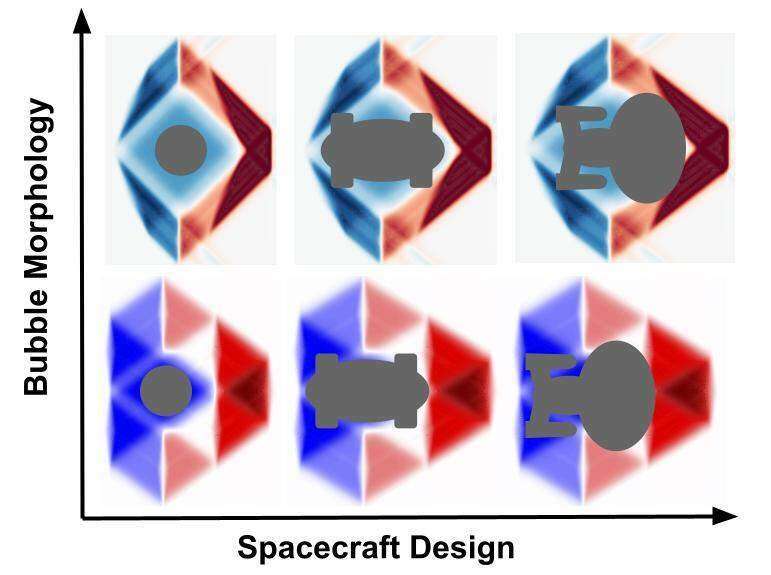
If travel to distant stars within an individual's lifetime is going to be possible, a means of faster-than-light propulsion will have to be found. To date, even recent research about superluminal (faster-than-light) transport based on Einstein's theory of general relativity would require vast amounts of hypothetical particles and states of matter that have 'exotic' physical properties such as negative energy density. This type of matter either cannot currently be found or cannot be manufactured in viable quantities. In contrast, new research carried out at the University of Göttingen gets around this problem by constructing a new class of hyper-fast 'solitons' using sources with only positive energies that can enable travel at any speed. This reignites debate about the possibility of faster-than-light travel based on conventional physics. The research is published in the journal Classical and Quantum Gravity .
The author of the paper, Dr. Erik Lentz, analyzed existing research and discovered gaps in previous 'warp drive' studies. Lentz noticed that there existed yet-to-be explored configurations of space-time curvature organized into 'solitons' that have the potential to solve the puzzle while being physically viable. A soliton—in this context also informally referred to as a 'warp bubble'—is a compact wave that maintains its shape and moves at constant velocity. Lentz derived the Einstein equations for unexplored soliton configurations (where the space-time metric's shift vector components obey a hyperbolic relation), finding that the altered space-time geometries could be formed in a way that worked even with conventional energy sources. In essence, the new method uses the very structure of space and time arranged in a soliton to provide a solution to faster-than-light travel , which—unlike other research—would only need sources with positive energy densities. No exotic negative energy densities needed.
If sufficient energy could be generated, the equations used in this research would allow space travel to Proxima Centauri, our nearest star, and back to Earth in years instead of decades or millennia. That means an individual could travel there and back within their lifetime. In comparison, the current rocket technology would take more than 50,000 years for a one-way journey. In addition, the solitons (warp bubbles) were configured to contain a region with minimal tidal forces such that the passing of time inside the soliton matches the time outside: an ideal environment for a spacecraft. This means there would not be the complications of the so-called 'twin paradox' whereby one twin traveling near the speed of light would age much more slowly than the other twin who stayed on Earth: in fact, according to the recent equations both twins would be the same age when reunited.
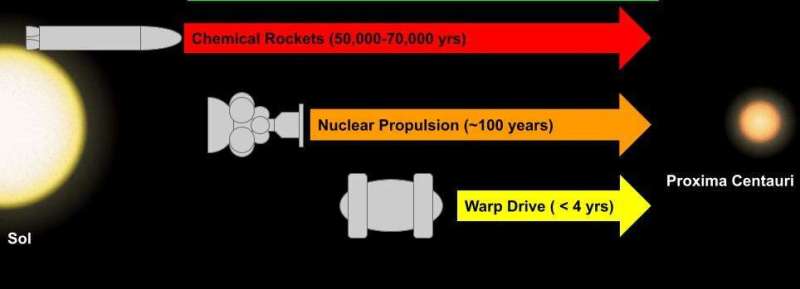
"This work has moved the problem of faster-than-light travel one step away from theoretical research in fundamental physics and closer to engineering. The next step is to figure out how to bring down the astronomical amount of energy needed to within the range of today's technologies, such as a large modern nuclear fission power plant. Then we can talk about building the first prototypes," says Lentz.
Currently, the amount of energy required for this new type of space propulsion drive is still immense. Lentz explains, "The energy required for this drive traveling at light speed encompassing a spacecraft of 100 meters in radius is on the order of hundreds of times of the mass of the planet Jupiter. The energy savings would need to be drastic, of approximately 30 orders of magnitude to be in range of modern nuclear fission reactors." He goes on to say: "Fortunately, several energy-saving mechanisms have been proposed in earlier research that can potentially lower the energy required by nearly 60 orders of magnitude." Lentz is currently in the early-stages of determining if these methods can be modified, or if new mechanisms are needed to bring the energy required down to what is currently possible.
Provided by University of Göttingen
Explore further
Feedback to editors

Every drop counts: New algorithm tracks Texas's daily reservoir evaporation rates
7 hours ago

Genetic study finds early summer fishing can have an evolutionary impact, resulting in smaller salmon
9 hours ago

Researchers discovery family of natural compounds that selectively kill parasites

Study suggests heavy snowfall and rain may contribute to some earthquakes
10 hours ago

The spread of misinformation varies by topic and by country in Europe, study finds

Webb presents best evidence to date for rocky exoplanet atmosphere

Human activity is making it harder for scientists to interpret oceans' past

Quantum simulators solve physics puzzles with colored dots

Chemists produce new-to-nature enzyme containing boron

Improving timing precision of millisecond pulsars using polarization
Relevant physicsforums posts, epr in bohm formulation.
5 hours ago
Why doesn't gravity cause double-slit decoherence?
When and why can ∂p/∂t=0 in position space.
13 hours ago
Could energy be destroyed during particle annihilation?
May 5, 2024
Bell tests: Changing detector settings "just before photon arrives"
X measurement modeled in non-separable hilbert space.
May 4, 2024
More from Quantum Physics
Related Stories

A potential model for a real physical warp drive
Mar 4, 2021

Don't stop me now! Superluminal travel in Einstein's universe
Nov 27, 2015

There's no way to measure the speed of light in a single direction
Jan 11, 2021

Colliding solitons in optical microresonators to reveal important fundamental physics
Apr 24, 2020

High Altitude Water Cherenkov observatory tests speed of light
Mar 31, 2020
The trouble with rockets
Jan 5, 2018
Recommended for you

Possible evidence of glueballs found during Beijing Spectrometer III experiments

Physicist achieve milestone in quantum simulation with circular Rydberg qubits
14 hours ago

The interference of many atoms, and a new approach to boson sampling
11 hours ago

Strictly no dancing: Researchers discover 'new molecular design rules'
12 hours ago

Physicists reach atomic-scale telegraphy with light
Let us know if there is a problem with our content.
Use this form if you have come across a typo, inaccuracy or would like to send an edit request for the content on this page. For general inquiries, please use our contact form . For general feedback, use the public comments section below (please adhere to guidelines ).
Please select the most appropriate category to facilitate processing of your request
Thank you for taking time to provide your feedback to the editors.
Your feedback is important to us. However, we do not guarantee individual replies due to the high volume of messages.
E-mail the story
Your email address is used only to let the recipient know who sent the email. Neither your address nor the recipient's address will be used for any other purpose. The information you enter will appear in your e-mail message and is not retained by Phys.org in any form.
Newsletter sign up
Get weekly and/or daily updates delivered to your inbox. You can unsubscribe at any time and we'll never share your details to third parties.
More information Privacy policy
Donate and enjoy an ad-free experience
We keep our content available to everyone. Consider supporting Science X's mission by getting a premium account.
E-mail newsletter

The idea that characters can fly from planet to planet, or star to star, defying current science and technology, is central to science fiction. Although some of these ideas predated the space age, after the 1950s, fictional depictions of space travel needed to suggest conceivable ways to cross interstellar distances to seem plausible. Some authors suggested faster-than-light drives, hyper drives, jump drives, worm holes, and black holes.
Scientific understanding of light speed as an absolute natural limit derives from Albert Einstein’s publications on special relativity in 1905, confirmed by his work on general relativity in 1916. In classical physics, speed has no limits. But relativistic theory shows that mass increases with acceleration until mass becomes infinite at light speed. Yet author E. E. “Doc” Smith imagined spaceships traveling faster than the speed of light in his “Skylark of Space” stories. Smith’s cover story appeared in the same issue of Amazing Stories in 1928 that included Philip Francis Nowlan’s first short story about Anthony (later “Buck”) Rogers.
Within a couple of decades, the fictional idea of faster-than-light travel made intuitive sense to a public familiar with recent supersonic flights. In 1947, Chuck Yeager broke the speed of sound aboard the Bell X-1 Glamorous Glennis . Writers extrapolated supersonic speeds into the idea of spacecraft traveling at multiples of the speed of light. Frank Hampson’s British comic Dan Dare offered one of the earliest uses of faster-than-light travel. In 1955, he introduced interstellar travel in “The Man from Nowhere” trilogy. The technology was inherently alien, however, and faster-than-light travel was not featured regularly afterward. Forbidden Planet (1956) was the first film to depict a fictional faster-than-light spaceship created by humans. From the exterior, the C-57D ship was an undifferentiated flying saucer. After a loudspeaker announcement, however, the crew stood in “DC stations” that held them immobile while the ship slowed. By the mid-1960s, however, as both the United States and the Soviet Union made regular human spaceflights, science fiction audiences became more intuitively aware of the time that it took to travel in space.
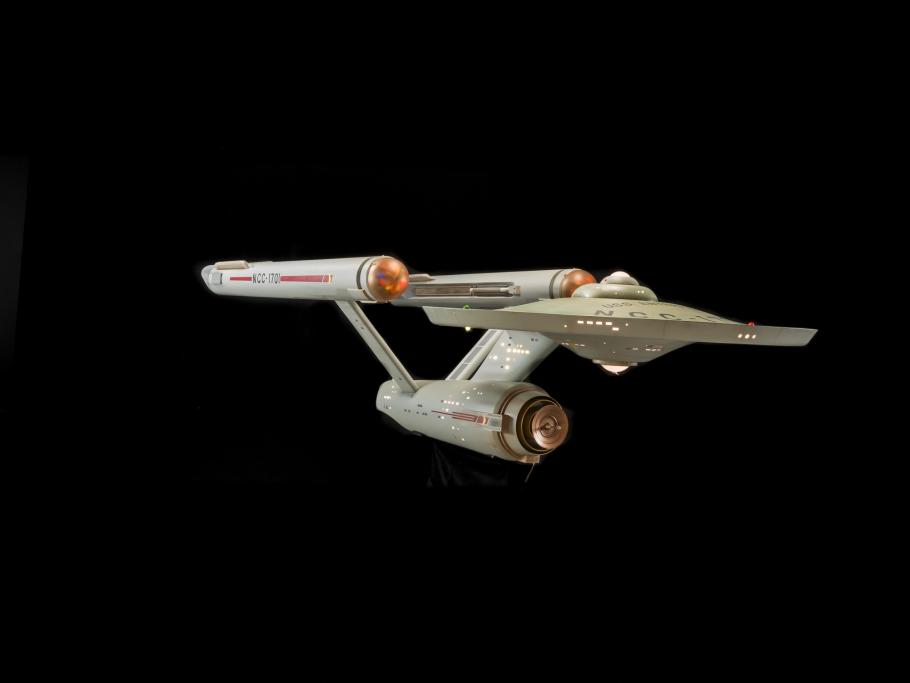
The U.S.S. Enterprise created for Star Trek (NBC, 1966-69) represented a major leap forward. Walters “Matt” Jefferies, a WWII flight engineer and private pilot, used “aircraft logic” to design a vehicle with components that visually communicated their purpose. With the two engine nacelles, Jefferies effectively invented warp drives, fictional engines that could propel the ship at multiples of the speed of light. As seen in Star Trek: First Contact (1996), the first flight of Zephram Cochran’s warp-capable Phoenix demonstrated the mark of a culture that was ready to participate in interstellar civilization. Jefferies’ design raised the bar for imagined vehicles. After Star Trek, undifferentiated flying saucers and flame-spewing pointed rockets largely disappeared from fictional depictions. Instead, imagined propulsion that bent space-time or traversed alternate dimensions become more prevalent.
Rather than just having the vehicles fly faster, some science fiction suggested traveling through or outside of normal four-dimensional space (including time), either by jumping within ordinary space, utilizing hyperspace, or exploiting natural or artificial shortcuts through space. Beginning in the 1940s, Isaac Asimov included jump drives in the short stories that later became his Foundation (1951) series of novels. Because fictional jump drives turn long flights into direct hops, allowing ships to disappear from one place and reappear in another, they facilitate storytelling without interrupting it. The reimagined Battlestar Galactica (2003) uses the same kind of travel but calls the mechanisms “FTL drives.”

A production model of the Millennium Falcon was on display at the Museum in 1998-99 as a part of the "Star Wars: The Magic of Myth".
The Star Wars universe postulates a hyperdrive, a computer-guided system that allows spacecraft to enter hyperspace at faster-than-light speeds and navigate to a successful exit at a distant destination. Solo: A Star Wars Story (2018) reveals that the extensive navigational maps and rapid calculating ability of the Millennium Falcon ’s hyperdrive computer are actually the downloaded memories of L3-37, a spirited and female-identified droid pilot.
The two-season program Buck Rogers in the 25th Century (NBC, 1979-1981) showed interstellar travel being accomplished using stargates. Four lights arranged in a diamond in space showed that the stargate had opened, offering access to hyperspace. A similar concept had a more physical presence in J. Michael Straczynski’s Babylon 5 (Syndicated & TNT, 1993-1998). In that show, external “jumpgates” shown using computer-generated imaging provided a physical infrastructure for generating stable vortices to hyperspace.
The idea of artificial space-time vortices as conduits drew power from speculation published in technical and popular literature. Speculation about wormholes must be distinguished, however, from black holes, which are real astronomical phenomena. Stories involving black holes often include time dilation. Einstein’s theories—including special and general relativity—explain that a person travelling near a massive gravitational field experiences time more slowly. The plot of director Christopher Nolan’s Interstellar (2014) employed time differences for dramatic purposes and also represented a giant leap in visual effects. To create the effect of the rapidly spinning black hole, theoretical astrophysicist Kip Thorne assisted the Interstellar production team. The resulting black hole appeared as a three-dimensional, spherical, hole in spacetime, drawing in all of the light around it. When the Event Horizon Telescope project imaged a real black hole in 2019, that image demonstrated how close to reality Interstellar ’s fictional imagination had come.
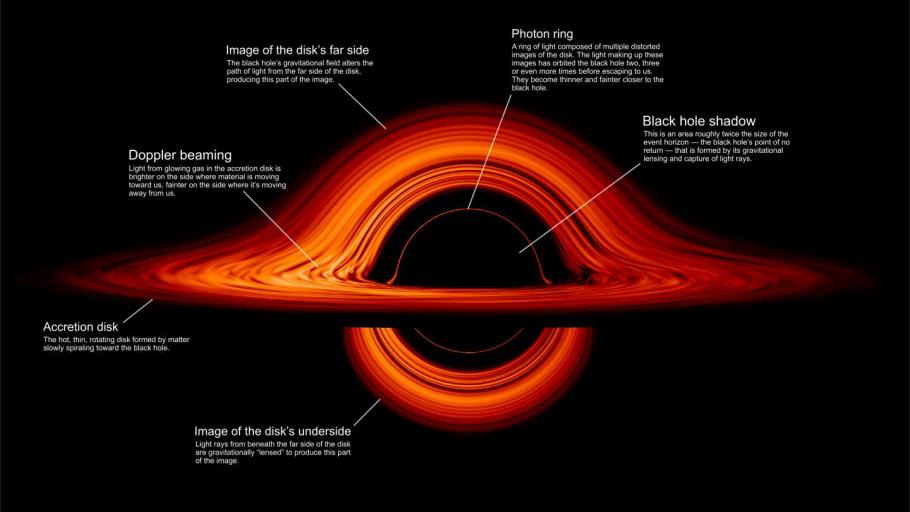
This explanation of the various aspects of a black hole shows the recent three-dimensional visualization.
Although writers have been imagining travel to space-based destinations for hundreds of years, the use of faster-than-light travel as a narrative device remains relatively young. As the sound barrier disappeared and the space age dawned, writers began imagining ways for interstellar travelers to cross the immensity of space. More important, audiences came to expect plausible explanations of faster-than-light travel to consider the stories credible.
Dr. Margaret A. Weitekamp is the Chair of the Museum’s Space History Department and author of “Ahead, Warp Factor Three, Mr. Sulu”: Imagining Interstellar Faster-Than-Light Travel in Space Science Fiction.” The Journal of Popular Culture 52 (2019), 1036-57.
We rely on the generous support of donors, sponsors, members, and other benefactors to share the history and impact of aviation and spaceflight, educate the public, and inspire future generations. With your help, we can continue to preserve and safeguard the world’s most comprehensive collection of artifacts representing the great achievements of flight and space exploration.
- Get Involved
- Host an Event
Thank you. You have successfully signed up for our newsletter.
Error message, sorry, there was a problem. please ensure your details are valid and try again..
- Free Timed-Entry Passes Required
- Terms of Use
Is NASA Actually Working On a Warp Drive?
Hyperspace, here we come!

- The Alcubierre drive uses a huge amount of energy to make a sort of fold-like pocket dimension.
- This technology is extremely far off , but thinking about it, experts say, could lead to breakthroughs .
Is NASA really working on . . . a warp drive ? An internal feasibility report suggests the agency might be, or at least that the idea of traveling through folded space is part of the NASA interstellar spaceflight menu.
The space agency isn’t building an engine that can approach the speed of light—yet. In the report, advanced propulsion physicist Harold "Sonny" White, PhD, now of Limitless Space , resolves a major paradox in the leading theoretical model for superluminal (faster than the speed of light) travel, what’s known as an Alcubierre warp drive.
The colloquial term “warp drive” comes from science fiction, most famously Star Trek. The faster-than-light warp drive of the Federation works by colliding matter and antimatter and converting the explosive energy to propulsion. The show suggests that this extraordinary power alone pushes the ship at faster-than-light speeds.
The Alcubierre drive, first proposed by theoretical physicist Miguel Alcubierre, conforms to Einstein’s theory of general relativity to achieve superluminal travel. It works a bit like the classic “tablecloth and dishes” party trick: The spaceship sits atop the tablecloth of spacetime, the drive pulls the fabric around it, and the ship is situated in a new place relative to the fabric.
Alcubierre describes spacetime expanding on one side of the ship and contracting on the other, thanks to an enormous amount of energy and a requisite amount of exotic matter—in this case, negative energy. Alcubierre's theory creates a kind of pocket in spacetime where a spaceship can operate outside of physics. He insists the requirement for exotic matter is not implausible within quantum mechanics.
The paradox holding back an Alcubierre, in addition to limitations like a lack of negative energy density, is that the direction of a spacecraft is arbitrary when the drive is used—there’s no steering it. Sci-fi has solved this paradox with “stable wormholes,” but NASA can’t fly a deus ex machina to Alpha Centauri.
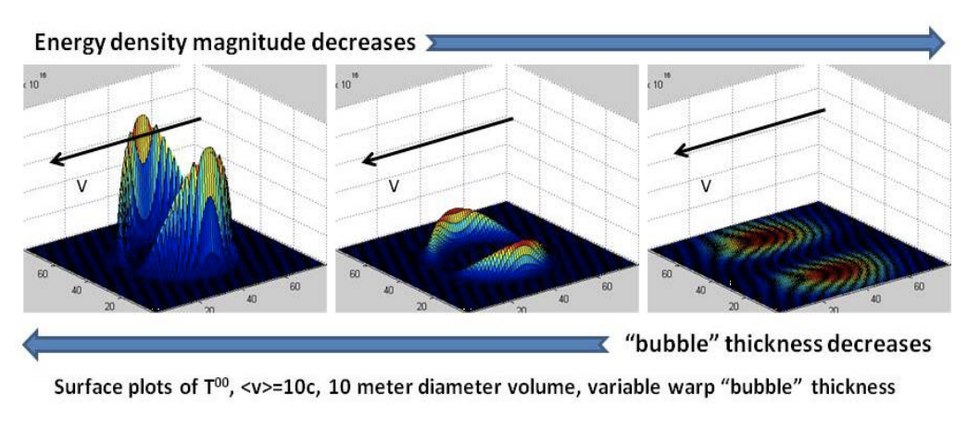
So White suggests a different paradigm in his report. Instead of a stationary spacecraft engaging the Alcubierre drive from a stopped position, White explains, “In this modified concept, the spacecraft departs earth, establishes an initial subluminal velocity, then initiates the field. The field’s boost acts on the initial velocity as a scalar multiplier, resulting in a much higher apparent speed.” The ship would use a rolling start as a directional cue.
In 2011, White conducted a field sensitivity analysis on Alcubierre’s model to see if he could shake loose any new insights. He found that Alcubierre’s original drive creates a relatively weak field, with negative vacuum energy on the side of the craft being pushed through a fold in spacetime. By making a more robust field, White says, “you could reduce the strain on spacetime so the amount of energy the trick takes to work is significantly reduced. Think metric ton as opposed to Jupiter.”
White suggests the proving ground for warp speed could be closer to home than the nearest stars. If scientists can make the so-called “negative mass” required for an Alcubierre drive, even a tiny example could be deployed within Earth’s atmosphere. “[T]he idea of a warp drive may have some fruitful domestic applications ‘subluminally,’ allowing it to be matured before it is engaged as a true interstellar drive system,” he explains.
An early example could drastically increase speed and reliability of carrying payloads into space. Using a small “beginner” warp drive, White suggests, will give scientists something to iterate as they grow the technology.

Caroline Delbert is a writer, avid reader, and contributing editor at Pop Mech. She's also an enthusiast of just about everything. Her favorite topics include nuclear energy, cosmology, math of everyday things, and the philosophy of it all.

.css-cuqpxl:before{padding-right:0.3125rem;content:'//';display:inline;} Science .css-xtujxj:before{padding-left:0.3125rem;content:'//';display:inline;}

Meet the Taam Ja': The World's Largest Blue Hole
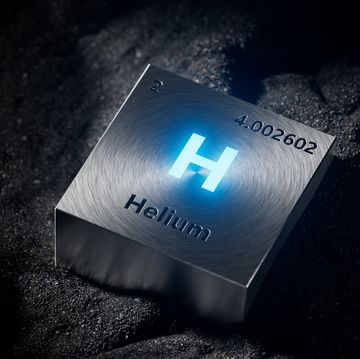
Huge Discovery Could Ease World's Helium Woes

Bodies Mysteriously Mummified in Andes Town

Ancient Egyptian Pharoah’s Vacation Home Unearthed

Did ‘Micro Buckling' Cause the Titan Sub’s Doom
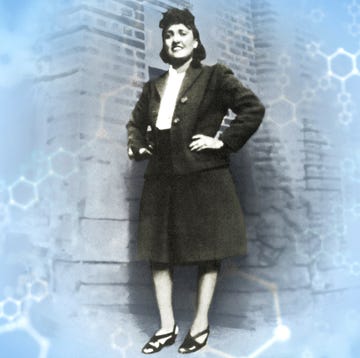
Henrietta Lacks Never Asked to Be Immortal
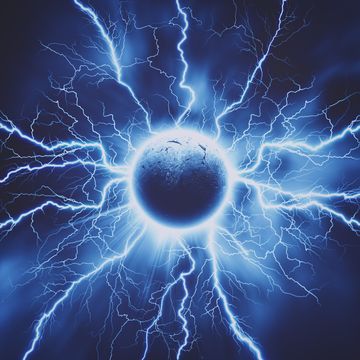
CERN Approves Project for Finding Hidden Particles

This 'Cage of Cages' Stores CO2 Faster Than Trees

5 Hydrothermal Vents Have Appeared in the Ocean

Archeologists Unearth a 12-Sided Roman Mystery

Lost Villa of Rome’s Augustus Potentially Found

Can anything travel faster than the speed of light?
Does it matter if it's in a vacuum?

In 1676, by studying the motion of Jupiter's moon Io, Danish astronomer Ole Rømer calculated that light travels at a finite speed. Two years later, building on data gathered by Rømer, Dutch mathematician and scientist Christiaan Huygens became the first person to attempt to determine the actual speed of light, according to the American Museum of Natural History in New York City. Huygens came up with a figure of 131,000 miles per second (211,000 kilometers per second), a number that isn't accurate by today's standards — we now know that the speed of light in the "vacuum" of empty space is about 186,282 miles per second (299,792 km per second) — but his assessment showcased that light travels at an incredible speed.
According to Albert Einstein 's theory of special relativity , light travels so fast that, in a vacuum, nothing in the universe is capable of moving faster.
"We cannot move through the vacuum of space faster than the speed of light," confirmed Jason Cassibry, an associate professor of aerospace engineering at the Propulsion Research Center, University of Alabama in Huntsville.
Question answered, right? Maybe not. When light is not in a vacuum, does the rule still apply?
Related: How many atoms are in the observable universe?
"Technically, the statement 'nothing can travel faster than the speed of light' isn't quite correct by itself," at least in a non-vacuum setting, Claudia de Rham, a theoretical physicist at Imperial College London, told Live Science in an email. But there are certain caveats to consider, she said. Light exhibits both particle-like and wave-like characteristics, and can therefore be regarded as both a particle (a photon ) and a wave. This is known as wave-particle duality.
If we look at light as a wave, then there are "multiple reasons" why certain waves can travel faster than white (or colorless) light in a medium, de Rham said. One such reason, she said, is that "as light travels through a medium — for instance, glass or water droplets — the different frequencies or colors of light travel at different speeds." The most obvious visual example of this occurs in rainbows, which typically have the long, faster red wavelengths at the top and the short, slower violet wavelengths at the bottom, according to a post by the University of Wisconsin-Madison .
Sign up for the Live Science daily newsletter now
Get the world’s most fascinating discoveries delivered straight to your inbox.
When light travels through a vacuum, however, the same is not true. "All light is a type of electromagnetic wave, and they all have the same speed in a vacuum (3 x 10^8 meters per second). This means both radio waves and gamma rays have the same speed," Rhett Allain, a physics professor at Southeastern Louisiana University, told Live Science in an email.
So, according to de Rham, the only thing capable of traveling faster than the speed of light is, somewhat paradoxically, light itself, though only when not in the vacuum of space. Of note, regardless of the medium, light will never exceed its maximum speed of 186,282 miles per second.
Universal look
According to Cassibry, however, there is something else to consider when discussing things moving faster than the speed of light.
"There are parts of the universe that are expanding away from us faster than the speed of light, because space-time is expanding," he said. For example, the Hubble Space Telescope recently spotted 12.9 billion year-old light from a distant star known as Earendel. But, because the universe is expanding at every point, Earendel is moving away from Earth and has been since its formation, so the galaxy is now 28 billion light years away from Earth.
In this case, space-time is expanding, but the material in space-time is still traveling within the bounds of light speed.
Related: Why is space a vacuum?
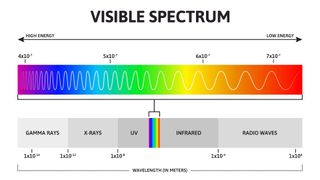
So, it's clear that nothing travels faster than light that we know of, but is there any situation where it might be possible? Einstein's theory of special relativity, and his subsequent theory of general relativity, is "built under the principle that the notions of space and time are relative," de Rham said. But what does this mean? "If someone [were] able to travel faster than light and carry information with them, their notion of time would be twisted as compared to ours," de Rham said. "There could be situations where the future could affect our past, and then the whole structure of reality would stop making sense."
This would indicate that it would probably not be desirable to make a human travel faster than the speed of light. But could it ever be possible? Will there ever be a time when we are capable of creating craft that could propel materials — and ultimately humans — through space at a pace that outstrips light speed? "Theorists have proposed various types of warp bubbles that could enable faster-than-light travel," Cassibry said.
But is de Rham convinced?
"We can imagine being able to communicate at the speed of light with systems outside our solar system ," de Rham said. "But sending actual physical humans at the speed of light is simply impossible, because we cannot accelerate ourselves to such speed.
"Even in a very idealistic situation where we imagine we could keep accelerating ourselves at a constant rate — ignoring how we could even reach a technology that could keep accelerating us continuously — we would never actually reach the speed of light," she added. "We could get close, but never quite reach it."
Related: How long is a galactic year?
This is a point confirmed by Cassibry. "Neglecting relativity, if you were to accelerate with a rate of 1G [Earth gravity], it would take you a year to reach the speed of light. However, you would never really reach that velocity because as you start to approach lightspeed, your mass energy increases, approaching infinite. "One of the few known possible 'cheat codes' for this limitation is to expand and contract spacetime, thereby pulling your destination closer to you. There seems to be no fundamental limit on the rate at which spacetime can expand or contract, meaning we might be able to get around this velocity limit someday."
— What would happen if the speed of light were much lower?
— What if the speed of sound were as fast as the speed of light?
— How does the rubber pencil illusion work?
Allain is similarly confident that going faster than light is far from likely, but, like Cassibry, noted that if humans want to explore distant planets, it may not actually be necessary to reach such speeds. "The only way we could understand going faster than light would be to use some type of wormhole in space," Allain said. "This wouldn't actually make us go faster than light, but instead give us a shortcut to some other location in space."
Cassibry, however, is unsure if wormholes will ever be a realistic option.
"Wormholes are theorized to be possible based on a special solution to Einstein's field equations," he said. "Basically, wormholes, if possible, would give you a shortcut from one destination to another. I have no idea if it's possible to construct one, or how we would even go about doing it." Originally published on Live Science.

Joe Phelan is a journalist based in London. His work has appeared in VICE, National Geographic, World Soccer and The Blizzard, and has been a guest on Times Radio. He is drawn to the weird, wonderful and under examined, as well as anything related to life in the Arctic Circle. He holds a bachelor's degree in journalism from the University of Chester.
Space photo of the week: A planet-size explosion rocks the sun's 'mossy' corona
China launches Chang'e 6 sample-return mission to moon's far side
32 weird technologies that never took off
Most Popular
- 2 Hundreds of black 'spiders' spotted in mysterious 'Inca City' on Mars in new satellite photos
- 3 Asteroid that exploded over Berlin was fastest-spinning space rock ever recorded
- 4 Cave of Crystals: The deadly cavern in Mexico dubbed 'the Sistine Chapel of crystals'
- 5 Why do dogs sniff each other's butts?
- 2 Cave of Crystals: The deadly cavern in Mexico dubbed 'the Sistine Chapel of crystals'
- 3 Hammer-headed bat: The African megabat that looks like a gargoyle and holds honking pageants
- 4 Antarctic ice hole the size of Switzerland keeps cracking open. Now scientists finally know why.

IMAGES
VIDEO
COMMENTS
The fastest ever spacecraft, the now- in-space Parker Solar Probe will reach a top speed of 450,000 mph. It would take just 20 seconds to go from Los Angeles to New York City at that speed, but it ...
New research suggests that it might be possible to build warp drives and beat the galactic speed limit. Faster than light travel is the only way humans could ever get to other stars in a ...
The proposed engine could not achieve faster-than-light travel, though it could come close; the statement mentions "high but subluminal speeds." RELATED STORIES: — How 'Star Trek' technology ...
If humanity ever wants to travel easily between stars, people will need to go faster than light. But so far, faster-than-light travel is possible only in science fiction.
The Alcubierre drive ( [alkuˈβjere]) is a speculative warp drive idea according to which a spacecraft could achieve apparent faster-than-light travel by contracting space in front of it and expanding space behind it, under the assumption that a configurable energy-density field lower than that of vacuum (that is, negative mass) could be created.
The secret to faster-than-light physics could be to double down on the number of dimensions, according to new research. ... (LSI), a group that funds and promotes far-out space travel and physics ...
The closest star to Earth is Proxima Centauri. It is about 4.25 light-years away, or about 25 trillion miles (40 trillion km). The fastest ever spacecraft, the now-in-space Parker Solar Probe will reach a top speed of 450,000 mph (201 km/s). It would take just 20 seconds to go from Los Angeles to New York City at that speed, but it would take the solar probe about 6,633 years to reach Earth ...
In order to travel at faster-than-light speeds, a warp drive would have to expand space behind a spacecraft and contract space in front, creating a warp bubble that surrounds the vessel ...
Star Trek suggests that this extraordinary power alone pushes the ship at faster-than-light speeds. Scientists have been studying and theorizing about faster-than-light space travel for decades.
Albert Einstein's special theory of relativity famously dictates that no known object can travel faster than the speed of light in vacuum, which is 299,792 km/s. This speed limit makes it unlikely that humans will ever be able to send spacecraft to explore beyond our local area of the Milky Way. However, new research by Erik Lentz at the ...
If I (THINK) about the sun to earth I have beat the light travel. Human thought is faster than light. Just for thought. Now let's get down to business. WARP DRIVE can be achieved. Anti-gravity is negative energy. Loaded in darkness of space. What u need in space is large amounts of gravity to pull or accelerate. Warp Drive is a push pull in a ...
This is an area that attracts plenty of bright ideas, each offering a different approach to solving the puzzle of faster-than-light travel: achieving a means of sending something across space at superluminal speeds.. Hypothetical travel times to Proxima Centauri, the nearest-known star to the Sun. (E. Lentz) There are some problems with this notion, however.
Faster-than-light ( superluminal or supercausal) travel and communication are the conjectural propagation of matter or information faster than the speed of light ( c ). The special theory of relativity implies that only particles with zero rest mass (i.e., photons) may travel at the speed of light, and that nothing may travel faster.
It is about 4.25 light-years away, or about 25 trillion miles (40 trillion km). The fastest ever spacecraft, the now-in-space Parker Solar Probe will reach a top speed of 450,000 mph. It would take just 20 seconds to go from Los Angeles to New York City at that speed, but it would take the solar probe about 6,633 years to reach Earth's ...
Faster-than-light travel: Is warp drive really possible? - BBC Science Focus Magazine.
In essence, the new method uses the very structure of space and time arranged in a soliton to provide a solution to faster-than-light travel, which—unlike other research—would only need ...
A warp drive or a drive enabling space warp is a fictional superluminal (faster than the speed of light) spacecraft propulsion system in many science fiction works, most notably Star Trek, and a subject of ongoing physics research. The general concept of "warp drive" was introduced by John W. Campbell in his 1957 novel Islands of Space and was popularized by the Star Trek series.
In 1955, he introduced interstellar travel in "The Man from Nowhere" trilogy. The technology was inherently alien, however, and faster-than-light travel was not featured regularly afterward. Forbidden Planet (1956) was the first film to depict a fictional faster-than-light spaceship created by humans. From the exterior, the C-57D ship was ...
The space agency isn't building an engine that can approach the speed of light—yet. ... (faster than the speed of light) travel, what's known as an Alcubierre warp drive. ...
Faster than light. 5 sci-fi space travel methods and the real theories behind them. by Bob Al-Greene (opens in a new tab) This post is part of Science of Sci-Fi (opens in a new tab) ...
So, according to de Rham, the only thing capable of traveling faster than the speed of light is, somewhat paradoxically, light itself, though only when not in the vacuum of space. Of note ...
Take a fascinating voyage through the world of theoretical physics with us as we investigate the intriguing idea of travelling faster than light—the Alcubierre Drive. Learn how this ground-breaking propulsion system bends space-time to produce a "warp bubble" that lets a spacecraft travel great distances without ever going faster than light.
Warp Drives and Wormholes: Can We Travel Faster Than Light? - Explore theoretical physics concepts like warp drives and wormholes that could revolutionize sp...